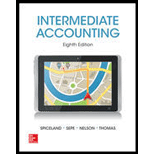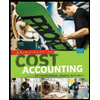
Intermediate Accounting w/ Annual Report; Connect Access Card
8th Edition
ISBN: 9781259546860
Author: J. David Spiceland
Publisher: McGraw-Hill Education
expand_more
expand_more
format_list_bulleted
Question
Chapter 17, Problem 17.6Q
To determine
Projected benefit obligation (PBO): This is the estimated present value of future retirement benefits, accumulated based on the future compensation levels.
To Name: The five events that might change the balance of the PBO.
Expert Solution & Answer
Want to see the full answer?
Check out a sample textbook solution
Students have asked these similar questions
Please explain the solution to this general accounting problem with accurate explanations.
Solve this Accounting problem
Can you solve this general accounting question with accurate accounting calculations?
Chapter 17 Solutions
Intermediate Accounting w/ Annual Report; Connect Access Card
Ch. 17 - Prob. 17.1QCh. 17 - Prob. 17.2QCh. 17 - Prob. 17.3QCh. 17 - What is the vested benefit obligation?Ch. 17 - Prob. 17.5QCh. 17 - Prob. 17.6QCh. 17 - Name three events that might change the balance of...Ch. 17 - Prob. 17.8QCh. 17 - Prob. 17.9QCh. 17 - Prob. 17.10Q
Ch. 17 - The return on plan assets is the increase in plan...Ch. 17 - Define prior service cost. How is it reported in...Ch. 17 - Prob. 17.13QCh. 17 - Is a companys PBO reported in the balance sheet?...Ch. 17 - What two components of pension expense may be...Ch. 17 - Prob. 17.16QCh. 17 - Evaluate this statement: The excess of the actual...Ch. 17 - Prob. 17.18QCh. 17 - TFC Inc. revises its estimate of future salary...Ch. 17 - Prob. 17.20QCh. 17 - Prob. 17.21QCh. 17 - Prob. 17.22QCh. 17 - The components of postretirement benefit expense...Ch. 17 - Prob. 17.24QCh. 17 - Prob. 17.25QCh. 17 - Prob. 17.26QCh. 17 - Prob. 17.1BECh. 17 - Prob. 17.2BECh. 17 - Prob. 17.3BECh. 17 - Prob. 17.4BECh. 17 - Prob. 17.5BECh. 17 - Prob. 17.6BECh. 17 - Prob. 17.7BECh. 17 - Prob. 17.8BECh. 17 - Prob. 17.9BECh. 17 - Prob. 17.10BECh. 17 - Net gain LO176 The projected benefit obligation...Ch. 17 - Prob. 17.12BECh. 17 - Prob. 17.13BECh. 17 - Prob. 17.14BECh. 17 - Prob. 17.15BECh. 17 - Prob. 17.1ECh. 17 - Prob. 17.2ECh. 17 - Prob. 17.3ECh. 17 - Prob. 17.4ECh. 17 - Prob. 17.5ECh. 17 - Prob. 17.6ECh. 17 - Prob. 17.7ECh. 17 - Prob. 17.8ECh. 17 - Prob. 17.9ECh. 17 - Prob. 17.10ECh. 17 - Prob. 17.11ECh. 17 - Prob. 17.12ECh. 17 - Prob. 17.13ECh. 17 - Prob. 17.14ECh. 17 - Prob. 17.15ECh. 17 - Prob. 17.16ECh. 17 - Prob. 17.17ECh. 17 - Prob. 17.18ECh. 17 - Prob. 17.19ECh. 17 - Prob. 17.20ECh. 17 - Prob. 17.21ECh. 17 - Prob. 17.22ECh. 17 - Prob. 17.23ECh. 17 - Prob. 17.24ECh. 17 - Prob. 17.25ECh. 17 - Prob. 17.26ECh. 17 - Prob. 17.27ECh. 17 - Prob. 17.28ECh. 17 - Prob. 17.29ECh. 17 - Prob. 17.30ECh. 17 - Prob. 17.31ECh. 17 - Prob. 17.32ECh. 17 - Prob. 17.33ECh. 17 - Prob. 1CPACh. 17 - Prob. 2CPACh. 17 - Prob. 3CPACh. 17 - Prob. 4CPACh. 17 - Prob. 5CPACh. 17 - Prob. 6CPACh. 17 - Prob. 7CPACh. 17 - Prob. 8CPACh. 17 - Prob. 1CMACh. 17 - Prob. 2CMACh. 17 - Prob. 17.1PCh. 17 - Prob. 17.2PCh. 17 - Prob. 17.3PCh. 17 - Prob. 17.4PCh. 17 - Prob. 17.5PCh. 17 - Prob. 17.6PCh. 17 - Prob. 17.7PCh. 17 - Prob. 17.8PCh. 17 - Prob. 17.9PCh. 17 - Prob. 17.10PCh. 17 - Prob. 17.11PCh. 17 - Prob. 17.12PCh. 17 - Prob. 17.13PCh. 17 - Prob. 17.14PCh. 17 - Prob. 17.15PCh. 17 - Prob. 17.16PCh. 17 - Prob. 17.17PCh. 17 - Prob. 17.18PCh. 17 - Prob. 17.19PCh. 17 - Prob. 17.20PCh. 17 - Prob. 17.21PCh. 17 - Prob. 17.1BYPCh. 17 - Prob. 17.2BYPCh. 17 - Prob. 17.3BYPCh. 17 - Prob. 17.5BYPCh. 17 - Prob. 17.6BYPCh. 17 - Prob. 17.8BYPCh. 17 - Prob. 17.9BYPCh. 17 - Prob. 17.10BYPCh. 17 - Prob. 17.12BYPCh. 17 - Prob. 1AFKC
Knowledge Booster
Similar questions
- Please explain the solution to this financial accounting problem with accurate explanations.arrow_forwardTony sold a building to Carol. The sales price was $420,000. Tony paid a commission to a real estate broker of $22,000 and paid other selling expenses of $5,800. Tony's basis in the building was $285,000. What was Tony's gain realized on the sale of the building?arrow_forwardI am trying to find the accurate solution to this general accounting problem with appropriate explanations.arrow_forward
- Please provide the answer to this general accounting question with proper steps.arrow_forwardsubject= general accountingarrow_forwardGalloway Corporation had $350,000 in sales on account last year. The beginning accounts receivable balance was $28,000, and the ending accounts receivable balance was $35,000. What is the company's average collection period? a. 30.11 days b. 27.38 days c. 32.85 days d. 25.47 daysarrow_forward
arrow_back_ios
SEE MORE QUESTIONS
arrow_forward_ios
Recommended textbooks for you
 College Accounting, Chapters 1-27AccountingISBN:9781337794756Author:HEINTZ, James A.Publisher:Cengage Learning,
College Accounting, Chapters 1-27AccountingISBN:9781337794756Author:HEINTZ, James A.Publisher:Cengage Learning, Intermediate Financial Management (MindTap Course...FinanceISBN:9781337395083Author:Eugene F. Brigham, Phillip R. DavesPublisher:Cengage Learning
Intermediate Financial Management (MindTap Course...FinanceISBN:9781337395083Author:Eugene F. Brigham, Phillip R. DavesPublisher:Cengage Learning Principles of Cost AccountingAccountingISBN:9781305087408Author:Edward J. Vanderbeck, Maria R. MitchellPublisher:Cengage Learning
Principles of Cost AccountingAccountingISBN:9781305087408Author:Edward J. Vanderbeck, Maria R. MitchellPublisher:Cengage Learning

College Accounting, Chapters 1-27
Accounting
ISBN:9781337794756
Author:HEINTZ, James A.
Publisher:Cengage Learning,

Intermediate Financial Management (MindTap Course...
Finance
ISBN:9781337395083
Author:Eugene F. Brigham, Phillip R. Daves
Publisher:Cengage Learning




Principles of Cost Accounting
Accounting
ISBN:9781305087408
Author:Edward J. Vanderbeck, Maria R. Mitchell
Publisher:Cengage Learning